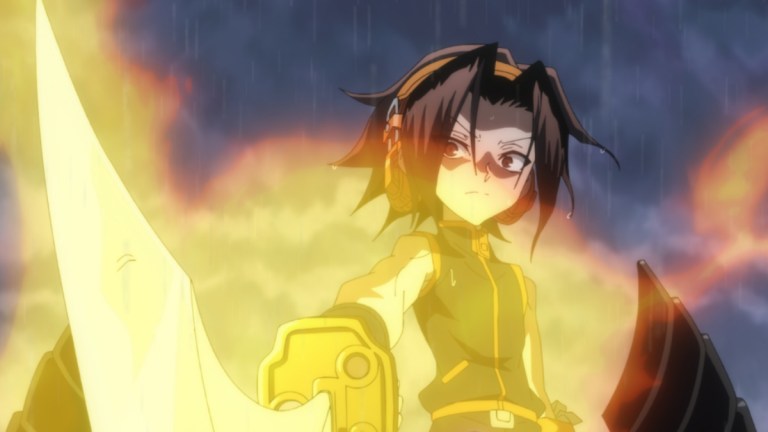Netflix’s Shaman King Adapts Too Much In Too Little Time
The 2021 Shaman King anime is far more faithful to the manga than the 2001 series but that doesn’t necessarily mean it’s better.

This article contains spoilers for Shaman King.
When a popular manga was adapted into an anime in the early 2000’s (or earlier) there was a pretty high chance that it’d be… lacking in some respect. Turn of the century anime often featured filler episodes, occasional weak animation, or just a less-than-perfect retelling of the manga’s story. This would often happen with any show adapting a currently running manga, forcing it to make up stories to catch up to what was being published.
This was the case for Shaman King, which received its first anime starting in 2001 (and later aired on FoxBox in 2003.) At first it hit most of the manga’s major story beats but it only took until the fourth episode for new filler content to appear. The second half of the series introduced substantial new elements that hadn’t been in the manga. It’s a fine series for what it is but for those clamoring for a true adaptation of Shaman King, it fell short.
That’s what made the announcement of the brand new Shaman King anime on Netflix (the show previously premiered in Japan on TV Tokyo) so exciting. The manga has long been over, meaning the new anime wouldn’t have to mess around with filler or come up with a new ending. It could just adapt the manga as is. Finally, the true adaptation of Shaman King could be realized!
The problem is that this adaptation is too faithful. It hardly cuts anything out. That doesn’t sound bad, right? This is the TRUE adaptation of Shaman King! They shouldn’t cut anything! I agree in theory, but as the show goes on the amount of manga chapters that make it into a single episode slowly creep up. The first episode adapts the first two chapters. Makes sense. The second adapts four chapters. Okay, that’s the entire first fight between lead character Yoh and his initial rival Ren… with a flashback to Yoh’s childhood thrown in at the end but that’s fine.
Much of the dialogue is lifted directly from the manga’s pages and even key panels are translated directly to the screen. At times it feels like the manga has truly come alive. The only thing they cut out are the early chapters of the manga where Yoh was collecting ghosts, which is understandable considering they have nothing to do with the tournament to become Shaman King and the manga itself forgets about them as well.
The third episode however adapts eight chapters, nearly the entire story of volume 2 featuring Yoh’s battle against Ren’s sister, Jun. The fourth episode, which covers goofy sidekick Ryu getting possessed by Tokageroh, is a huge chunk of volume three. The rest of the episodes adapt huge chunks of other volumes, usually around seven chapters worth of material.
This is a problem because shoving that much story into each episode makes the plot feel incredibly rushed. Characters talk at lightning speed. The action isn’t given room to breathe. Events hit you one after the other so fast you don’t have time to process it. The few things that are cut are mostly the downtime in fights, moments when characters on the sidelines talk about what’s happening to lend weight to what’s going on.
An example of this is episode seven, which covers Yoh’s battle with necromancer Faust. In the manga there’s a long scene in a restaurant where Shaman Fight officiator Silva tries to convince Yoh’s fiancée Anna that Yoh should forfeit his match against Faust. It helps to convey just how big a threat Faust is and sets up a series of cutaways during the battle where Anna and Silva discuss Yoh’s chances in the fight. It helps to develop Silva’s growing interest and favoritism towards Yoh and reaffirms Anna’s commitment to him.
In the anime the initial scene between the two in the restaurant is truncated to a mere 25 seconds of screen time, with no set-up to how the two ended up in the restaurant (which was shown in the manga.) It’s merely there to deliver the exposition of why Faust is a threat but sucks all the character out of the scene. If you hadn’t read the manga you’d wonder why Silva and Anna are sharing a scene together like this. This happens frequently throughout the anime and trying to shove too much content into one episode is what causes it.
The anime tries to have it two ways. It wants to put as much of the manga into its story as possible but then is forced to cut little sections out to make it work, which robs what is there of its impact. This is where the original 2001 Shaman King anime has the new one beat.
Despite its filler content, that series wisely knew these fights were important and devoted time to them. The Faust fight, which takes up only one episode in the new series, took two in the original. The same with the initial Ren fight, the fight against Jun, the possession of Ryu, and so on. Sure these episodes sprinkled in some new content but they were still mostly accurate representations of the manga but instead of adapting seven or more chapters per episode it was more a comfortable three.
To make a larger comparison, the amount of story used to cover roughly the first nine volumes of the manga takes 13 episodes in the new anime and 25 in the original. Now to be fair, the original anime had around 3 to 4 episodes worth of filler content in there but that’s still about 9 episodes worth of extra breathing room to tell the story.
So why is the show like this? If they have the whole manga already why not take their time when they need to? That would be because of the already approved episode count. According to the official website of the new Shaman King anime, as reported by Anime News Network, the series is set to run 52 episodes to fit into four Blu-ray box sets of 13 episodes each. This explains why the show feels so rushed. They want to adapt the entire manga but have a limited timeframe to do so.
To illustrate why this is such a problem, let’s take a look at the Fullmetal Alchemist series. That was originally a manga that got an anime adaption that wasn’t a perfect match to the manga’s story (they even went in their own direction midway through.) Later, however, it got a more faithful and beloved adaptation, Fullmetal Alchemist: Brotherhood. That anime lasted 64 episodes compared to the 27 volumes of the manga it was adapting. What makes this relevant is when you realize that the 2021 Shaman King series has 52 episodes to adapt 35 volumes of manga.
That means that every episode of the new anime is forced to adapt, at minimum, six or so chapters of the manga if they’re trying to adapt all 300 chapters in 52 episodes. It’s a near impossible task and robs Shaman King of what makes it so great: The philosophy of Yoh.
Yoh believes that everything will work out in the end. He doesn’t rush things; he takes them at his own pace. His goal is to become Shaman King so he can relax. That laidback attitude is what sets Shaman King apart from many of its shonen contemporaries. Even in big battles Yoh wants to take things easy, famously telling Ren in their rematch that using more power would take too much work.
When the anime is forced to rush the story, it takes all that power away from Yoh. We don’t get to feel his chill attitude. We don’t get to ruminate on things as he did. It’s just characters talking one after the other endlessly so we can adapt nearly every chapter of the manga. So yes, the 2021 Shaman King is a faithful adaptation in the technical sense. But when you compare it to the manga, where you have time to appreciate the gorgeous art and don’t have to read the dialogue a mile a minute? The anime feels as though it’s lacking the true soul of Shaman King.
The first 13 episodes of Shaman King are available to stream on Netflix now.
